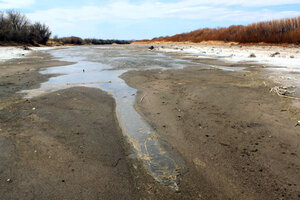Cities that depend on snowmelt for water could face problems, study suggests
A new study finds that when more precipitation falls as rain instead of snow, stream flows in drainage basins decline. This could complicate matters for areas that need snowmelt for water.

The Rio Grande is reduced to a trickle of water near the chile growing community of Hatch, N.M., in this 2013 photo. A new study looks at the effect of snowfall on stream flows.
Susan Montoya Bryan/AP/File
Managing water resources in a changing climate may get more complicated for regions relying on melt from mountain snows.
A team of researchers has found preliminary evidence that when an increasing proportion of winter precipitation falls as rain, rather than snow, the amount of water flowing through drainage basins and into rivers in the US undergoes a long-term decline.
The study, published Sunday in the journal Nature Climate Change, estimates that for a increase of 2.4 degrees Celsius (4.3 degrees F.), increases in the proportion of rain falling at the expense of snow could lead to a decline of 12 percent or more in stream flows.
If the observations hold up to additional scrutiny "and if they reflect some fundamental response to climate change, then the problems for water managers are going to be even more complicated that we already fear they are," says Peter Gleick, who heads the Pacific Institute, a think tank based in Oakland, Calif., that focuses on sustainable use of water and other environmental issues.
For nearly 30 years, research has shown that as the climate warms, a rising percentage of precipitation will fall as rain, rather than snow, even if global warming had no effect on the overall amount of rain or snow falling in a region. In addition, spring comes earlier, reducing the time available for snow to accumulate.
During the past 50 years, these trends have taken hold throughout the Southwest, according to the Third National Climate Assessment, released in early May. Between 2001 and 2010 flows in major rivers such as the Colorado, Rio Grande, and the Sacramento-San Joaquin system have experienced reductions in flow ranging from 5 to 37 percent compared with the 20th century average. The US geological Survey has measured a 20 percent decline in snow cover in the Rocky Mountains since 1980, due a mix of global warming and natural variability.
That leaves less snow held in high-altitude storage to melt in the summer, when conditions are hotter and drier below. The big concern for water managers in the West involves this change in timing, which sends more water downhill when it's least needed, leaving less available when it's most needed.
But few have looked at the impact the shift in precipitation type alone could have on stream flow, explains the team, led by Wouter Berghuijs, a PhD student at the University of Bristol in Britain.
Finding an apparent relationship between the proportion of winter precipitation falling as snow and stream flows was not what Mr. Berghuijs had in mind when he began the work, he explains.
The team's study is based on data from 420 drainage basins from Maine to California covering areas ranging in size from 27 to nearly 3,900 square miles. The researchers selected basins that were least affected by human development or land-use changes and that had good-quality stream-flow records spanning decades. Many of the stream gauges the team tapped have been taking measurements since 1948, with an average across all gauges of 47 years.
Initially, Berghuijs says he was trying to evaluate models that predict stream flows to see which worked best with particular types of drainage basins, or catchments.
As he and colleague Ross Woods, a lecturer in civil engineering at the University of Bristol, looked over the data, they were struck by initial indications that as the proportion of snow in winter precipitation increased, so did stream flow. As the proportion declined, so did average stream flow.
The team first looked at data from all 420 basins and found that as the fraction of precipitation falling as snow increased, so did stream flow. Then they focused on 97 basins for which snow made up more than 15 percent of a winter's precipitation. The pattern repeated, with these basins showing evidence of being quite sensitive to changes in the rain-snow mix.
The study is something of an initial tug on the shirtsleeves to other researchers working to understand the interplay of climate change with hydrology. Long-term changes in the amount of precipitation falling in a region could make up for the decline in stream flow, the researchers acknowledge.
It doesn't attempt to break the data down by region, something they and Dr. Gleick say is a logical next step.
Nor does it address possible causes for the trend. With earlier, warmer springs, for example, vegetation would be sprouting earlier, drawing more heavily on moisture that otherwise would migrate to streams and rivers. But trying to measure such activity on a basinwide scale is difficult, Berghuijs says.
Still, he adds, he and his colleagues have identified the effect, which appears consistently and across a wide range of catchment types.
"It's a start for really trying to understand why this is happening" and to see how the effect varies from catchment to catchment, Berghuijs says.

